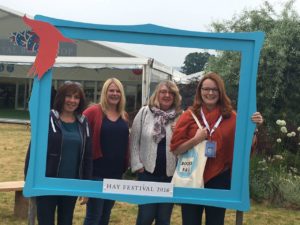A healthy, happy workforce in homecare

Michael Marmot started his talk with Alan’s story. This was the most impactful talk that I heard at the Hay Festival this year. Hay is the literary equivalent of Glastonbury, and one of the highlights of my year. As a team we rent a house, have our team meeting on the Friday, and then spend a couple of days at the festival. On Saturday morning, I was sat on the second row at the Good Energy stage, with Michelle, Emily and Vicky, listening to Sir Michael Marmot, author of the book ‘The Health Gap”.
Alan was a picker in a warehouse, and Michael described in detail his daily experiences of work. He ended the story with,
“it was as if his employers had taken everything we know about the damaging aspects of work, concentrated them in a syringe and injected them into Alan.”
The damaging effects that he refers to are high demand with no control over the work task, high effort and little reward, social isolation at work, job insecurity and shift work.
When I met Michael Marmot after his talk, I asked him if he thought some of these aspects related to homecare as well. He agreed that they could. I am not suggesting that every carer who works in homecare experiences these damaging aspects, but I am sure many do.
As well as Marmot’s book, The Health Gap, I am also reading ‘The Best Place to Work – the art and science of creating an extraordinary workplace” by Ron Friedman. I have been thinking about this in relation to homecare. I wonder if we can create a different way of delivering support for people at home, that is really person-centred, and delivered by a happy, flexible workforce? Buurtzorg demonstrates that this is possible, within a different context, with qualified nurses. Can we achieve the same results within homecare and have a happy workforce?
Friedman offers 3 lessons on how to create a happy workforce:
Lesson 1 – Psychological needs are at the heart of employee engagement.
Lesson 2 – Organisations are more successful when they address the limits of mind and body.
Lesson 3 – Integrating work and family life improves the quality of both.
The psychological needs that he refers to are autonomy and relationships. It seems that choice and control matters to staff as well as people using services, and that having friends at work is critical to productivity and happiness.
The self-managed teams of Buurtzorg maximise employees autonomy and enable people to organise their own rotas. Being in a small team of 10 – 12, and working together to serve a neighbourhood fosters close relationships.
I am part of a small team, with Greg Bamber and Liz Walker from Caring Hands, and Dr. Rod Kersh, working to establish a new homecare team in Doncaster, that uses the same principles as Buurtzorg. Our vision is to deliver support at home that is person-centred and co-designed with the person: flexible and neighbourhood based; cost effective; and delivered by happy self-managing teams. It almost makes me gulp as I write it – it sounds so audacious.
I am sure that as you are reading this you can already see many, many difficulties to delivering homecare differently, and I agree that this is a huge challenge. I will share in my blogs what we are trying, where we fail and what we learn from this, and hopefully some successes too.
Michael Marmot was compelling that we need a radical change in the way we think about health and society. This means not only ensuring that older people are supported well at home, but that the health and happiness of staff is critical too.
